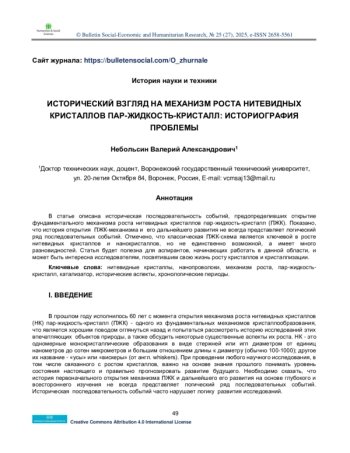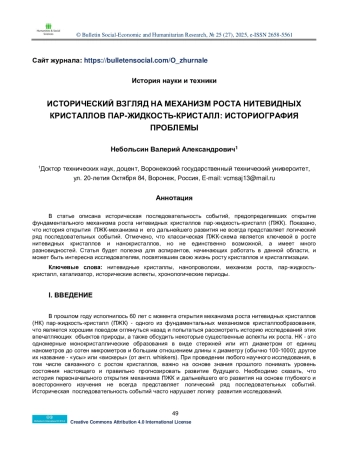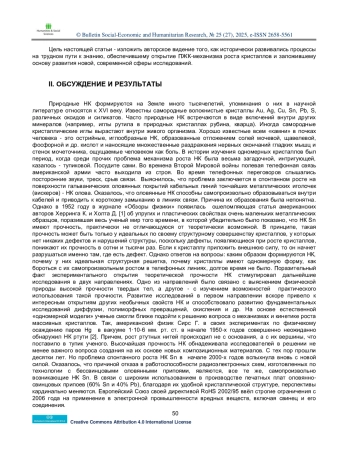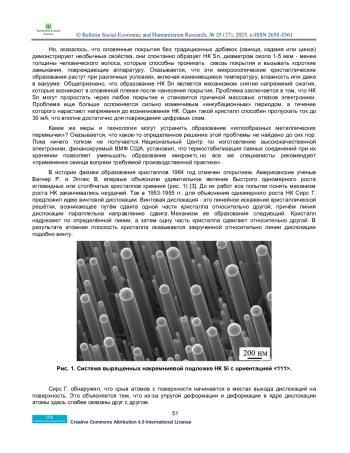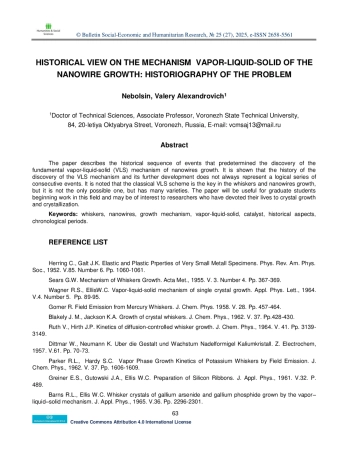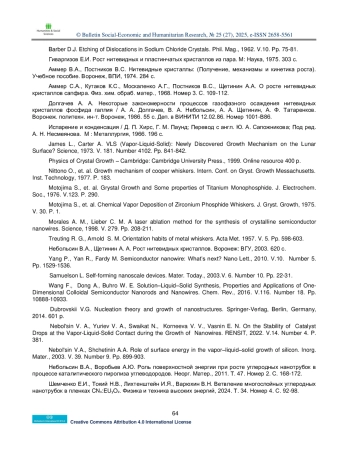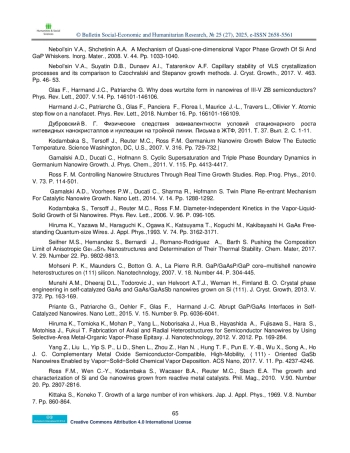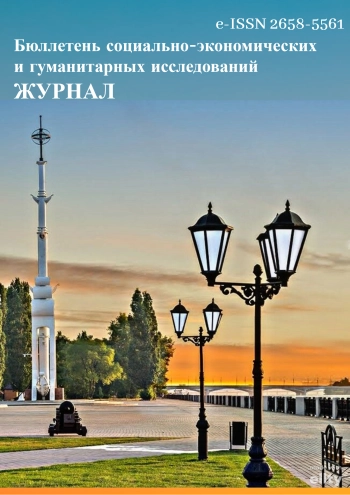The paper describes the historical sequence of events that predetermined the discovery of the fundamental vapor-liquid-solid (VLS) mechanism of nanowires growth. It is shown that the history of the discovery of the VLS mechanism and its further development does not always represent a logical series of consecutive events. It is noted that the classical VLS scheme is the key in the whiskers and nanowires growth, but it is not the only possible one, but has many varieties. The paper will be useful for graduate students beginning work in this field and may be of interest to researchers who have devoted their lives to crystal growth and crystallization.
В статье описана историческая последовательность событий, предопределивших открытие фундаментального механизма роста нитевидных кристаллов пар-жидкость-кристалл (ПЖК). Показано, что история открытия ПЖК-механизма и его дальнейшего развития не всегда представляет логический ряд последовательных событий. Отмечено, что классическая ПЖК-схема является ключевой в росте нитевидных кристаллов и нанокристаллов, но не единственно возможной, а имеет много разновидностей. Статья будет полезна для аспирантов, начинающих работать в данной области, и может быть интересна исследователям, посвятившим свою жизнь росту кристаллов и кристаллизации.
Идентификаторы и классификаторы
Список литературы
1. Herring C., Galt J.K. Elastic and Plastic Prperties of Very Small Metall Specimens. Phys. Rev. Am. Phys. Soc., 1952. V.85. Number 6. Pp. 1060-1061.
2. Sears G.W. Mechanism of Whiskers Growth. Acta Met., 1955. V. 3. Number 4. Pp. 367-369.
3. Wagner R.S., Ellis W.C. Vapor-liquid-solid mechanism of single crystal growth. Appl. Phys. Lett., 1964. V.4. Number 5. Pp. 89-95. EDN: SQGEXR
4. Gomer R. Field Emission from Mercury Whiskers. J. Chem. Phys. 1958. V. 28. Pp.457-464.
5. Blakely J. M., Jackson K.A. Growth of crystal whiskers. J. Chem. Phys., 1962. V. 37. Pp.428-430.
6. Ruth V., Hirth J.P. Kinetics of diffusion-controlled whisker growth. J. Chem. Phys., 1964. V. 41. Pp. 3139-3149.
7. Dittmar W., Neumann K. Uber die Gestalt und Wachstum Nadelformigel Kaliumkristall. Z. Electrochem, 1957. V.61. Pp. 70-73.
8. Parker R.L., Hardy S.C. VaporPhase Growth Kinetics of Potassium Whiskers by Field Emission. J. Chem. Phys., 1962. V. 37. Pp. 1606-1609.
9. Greiner E.S., Gutowski J.A., Ellis W.C. Preparation of Silicon Ribbons. J. Appl. Phys., 1961. V.32. P. 2489.
10. Barns R.L., Ellis W.C. Whisker crystals of gallium arsenide and gallium phosphide grown by the vaporliquidsolid mechanism. J. Appl. Phys., 1965. V.36. Pp. 2296-2301.
11. Barber D.J. Etching of Dislocations in Sodium Chloride Crystals. Phil. Mag., 1962. V.10. Pp. 75-81.
12. Гиваргизов E.И. Рост нитевидных и пластинчатых кристаллов из пара. М: Наука, 1975. 303 с.
13. Аммер В.А., Постников В.С. Нитевидные кристаллы: (Получение, механизмы и кинетика роста). Учебное пособие. Воронеж, ВПИ, 1974. 284 с.
14. Аммер С.А., Кутаков К.С., Москаленко А.Г., Постников В.С., Щетинин А.А. О росте нитевидных кристаллов сапфира. Физ. хим. обраб. матер., 1968. Номер 3. С. 109-112.
15. Долгачев А. А. Некоторые закономерности процессов газофазного осаждения нитевидных кристаллов фосфида галлия / А. А. Долгачев, В. А. Небольсин, А. А. Щетинин, А. Ф. Татаренков. Воронеж. политехн. ин-т. Воронеж, 1986. 55 с. Деп. в ВИНИТИ 12.02.86. Номер 1001-В86.
16. Испарение и конденсация / Д. П. Хирс, Г. М. Паунд; Перевод с англ. Ю. А. Сапожникова; Под ред. А. Н. Несмеянова. M: Металлургия, 1966. 196 с.
17. James L., Carter A. VLS (Vapor-Liquid-Solid): Newly Discovered Growth Mechanism on the Lunar Surface? Science, 1973. V. 181. Number 4102. Pp. 841-842.
18. Physics of Crystal Growth Cambridge: Cambridge University Press., 1999. Оnline resource 400 p.
19. Nittono O., et. al. Growth mechanism of cooper whiskers. Intern. Conf. on Gryst. Growth Messachusetts. Inst. Technology, 1977. P. 183.
20. Motojima S., et. al. Grystal Growth and Some properties of Titanium Monophosphide. J. Electrochem. Soc., 1976. V.123. P. 290.
21. Motojima S., et. al. Chemical Vapor Deposition of Zirconium Phosphide Whiskers. J. Gryst. Growth, 1975. V. 30. P. 1.
22. Morales A. M., Lieber C. M. A laser ablation method for the synthesis of crystalline semiconductor nanowires. Science, 1998. V. 279. Pp. 208-211. EDN: YCYSKT
23. Treuting R. G., Arnold S. M. Orientation habits of metal whiskers. Acta Met. 1957. V. 5. Pp. 598-603.
24. Небольсин В.А., Щетинин А. А. Рост нитевидных кристаллов. Воронеж: ВГУ, 2003. 620 с.
25. Yang P., Yan R., Fardy M. Semiconductor nanowire: Whats next? Nano Lett., 2010. V.10. Number 5. Pp.15291536. EDN: OAXCTV
26. Samuelson L. Self-forming nanoscale devices. Mater. Today., 2003.V. 6. Number 10. Pp. 22-31.
27. Wang F., Dong A., Buhro W. E. Solution Liquid Solid Synthesis, Properties and Applications of One-Dimensional Colloidal Semiconductor Nanorods and Nanowires. Chem. Rev., 2016. V.116. Number 18. Pp. 10888-10933. EDN: XTWDXT
28. Dubrovskii V.G. Nucleation theory and growth of nanostructures. Springer-Verlag, Berlin, Germany, 2014. 601 p.
29. Nebolsin V. A., Yuriev V. A., Swaikat N., Korneeva V. V., Vasnin E. N. On the Stability of Catalyst Drops at the Vapor-Liquid-Solid Contact during the Growth of Nanowires. RENSIT, 2022. V.14. Number 4. P. 381.
30. Nebolsin V.A., Shchetinin A.A. Role of surface energy in the vaporliquidsolid growth of silicon. Inorg. Mater., 2003. V. 39. Number 9. Pp. 899-903. EDN: LHVCBH
31. Небольсин В.А., Воробьев А.Ю. Роль поверхностной энергии при росте углеродных нанотрубок в процессе каталитического пиролиза углеводородов. Неорг. Матер., 2011. Т. 47. Номер 2. С. 168-172.
32. Шемченко Е.И., Токий Н.В., Лихтенштейн И.Я., Варюхин В.Н. Ветвление многослойных углеродных нанотрубок в пленках CNx:EUyOz. Физика и техника высоких энергий, 2024. Т. 34. Номер 4. С. 92-98.
33. Nebolsin V.A., Shchetinin A.A. A Mechanism of Quasi-one-dimensional Vapor Phase Growth Of Si And GaP Whiskers. Inorg. Mater., 2008. V. 44. Pp. 1033-1040. EDN: LLKBXN
34. Nebolsin V.A., Suyatin D.B., Dunaev A.I., Tatarenkov A.F. Capillary stability of VLS crystallization processes and its comparison to Czochralski and Stepanov growth methods. J. Cryst. Growth., 2017. V. 463. Pp. 46- 53.
35. Glas F., Harmand J.C., Patriarche G. Why does wurtzite form in nanowires of III-V ZB semiconductors? Phys. Rev. Lett., 2007. V.14. Pp. 146101146106.
36. Harmand J.-C., Patriarche G., Glas F., Panciera F., Florea I., Maurice J.-L., Travers L., Ollivier Y. Atomic step flow on a nanofacet. Phys. Rev. Lett., 2018. Number 16. Pp. 166101-66109.
37. Дубровский В. Г. Физические следствия эквивалентности условий стационарного роста нитевидных нанокристаллов и нуклеации на тройной линии. Письма в ЖТФ, 2011. Т. 37. Вып. 2. С. 1-11.
38. Kodambaka S., Tersoff J., Reuter M.C., Ross F.M. Germanium Nanowire Growth Below The Eutectic Temperature. Science Washington, DC, U.S., 2007. V. 316. Pp. 729-732. EDN: MMCGON
39. Gamalski A.D., Ducati C., Hofmann S. Cyclic Supersaturation and Triple Phase Boundary Dynamics in Germanium Nanowire Growth. J. Phys. Chem., 2011. V. 115. Pp. 4413-4417. EDN: OCDEND
40. Ross F. M. Controlling Nanowire Structures Through Real Time Growth Studies. Rep. Prog. Phys., 2010. V. 73. P. 114-501.
41. Gamalski A.D., Voorhees P.W., Ducati C., Sharma R., Hofmann S. Twin Plane Re-entrant Mechanism For Catalytic Nanowire Growth. Nano Lett., 2014. V. 14. Pp. 1288-1292. EDN: SSSKAF
42. Kodambaka S., Tersoff J., Reuter M.C., Ross F.M. Diameter-Independent Kinetics in the Vapor-Liquid-Solid Growth of Si Nanowires. Phys. Rev. Lett., 2006. V. 96. P. 096105.
43. Hiruma K., Yazawa M., Haraguchi K., Ogawa K., Katsuyama T., Koguchi M., Kakibayashi H. GaAs Free-standing Quantum-size Wires. J. Appl. Phys.,1993. V. 74. Pp. 3162-3171. EDN: YKLWMO
44. Seifner M.S., Hernandez S., Bernardi J., Romano-Rodriguez A., Barth S. Pushing the Composition Limit of Anisotropic Ge1xSnx Nanostructures and Determination of Their Thermal Stability. Chem. Mater, 2017. V. 29. Number 22. Pp. 9802-9813.
45. Mohseni P. K., Maunders C., Botton G. A., La Pierre R.R. GaP/GaAsP/GaP coremultishell nanowire heterostructures on (111) silicon. Nanotechnology, 2007. V. 18. Number 44. P. 445304. EDN: MMAQEP
46. Munshi A.M., Dheeraj D.L., Todorovic J., van Helvoort A.T.J., Weman H., Fimland B. O. Crystal phase engineering in self-catalyzed GaAs and GaAs/GaAsSb nanowires grown on Si (111). J. Cryst. Growth, 2013. V. 372. Pp. 163-169.
47. Priante G., Patriarche G., Oehler F., Glas F., Harmand J.-C. Abrupt GaP/GaAs Interfaces in Self-Catalyzed Nanowires. Nano Lett., 2015. V. 15. Number 9. Pp. 6036-6041. EDN: VEVKQH
48. Hiruma K., Tomioka K., Mohan P., Yang L., Noborisaka J., Hua B., Hayashida A., Fujisawa S., Hara S., Motohisa J., Fukui T. Fabrication of Axial and Radial Heterostructures for Semiconductor Nanowires by Using Selective-Area Metal-Organic Vapor-Phase Epitaxy. J. Nanotechnology, 2012. V. 2012. Pp. 169-284.
49. Yang Z., Liu L., Yip S. P., Li D., Shen L., Zhou Z., Han N., Hung T. F., Pun E. Y.-B., Wu X., Song A., Ho J. C. Complementary Metal Oxide Semiconductor-Compatible, High-Mobility, 111- Oriented GaSb Nanowires Enabled by VaporSolidSolid Chemical Vapor Deposition. ACS Nano, 2017. V. 11. Pp. 4237-4246.
50. Ross F.M., Wen C.-Y., Kodambaka S., Wacaser B.A., Reuter M.C., Stach E.A. The growth and characterization of Si and Ge nanowires grown from reactive metal catalysts. Phil. Mag., 2010. V.90. Number 20. Pp. 2807-2816.
51. Kittaka S., Koneko T. Growth of a large number of iron whiskers. Jap. J. Appl. Phys., 1969. V.8. Number 7. Pp. 860-864.
Выпуск
Другие статьи выпуска
The article deals with the process of struggle of the Komsomol organization with opposition and alternative associations of youth in Simbirsk (Ulyanovsk) province in 1918 - 1928. The authors on the basis of archival materials from the State Archive of Modern History of the Ulyanovsk region, ego-documents and periodicals, introduced for the first time in the scientific turnover, touch upon the formation of the Komsomol movement in the region, reveal the peculiarities of its interaction with the party and law enforcement agencies in the fight against non-communist youth organizations. The work scrupulously analyzes the process of obtaining the Komsomol monopoly on the implementation of work with young people. In conclusion it is noted that in Simbirsk (Ulyanovsk) provincial Komsomol organization and its subordinate committees, despite the regularly arising difficulties, managed to establish at a high level of interaction with party structures and securing the support of law enforcement agencies to carry out the liquidation of all alternative and opposition youth organizations operating in the region, providing itself a monopoly position.
The article reveals the reasons and prerequisites for the development of automobile transportation in the USSR and in the Kemerovo region in the late XIX century - early 1940-s. The article does not provide a historiographical review, as there are practically no works on this topic. Recently, there have been defended several PhD theses on the history of motor transportation, but almost all of them are devoted to the post-war period. This article shows mainly the reasons and prerequisites for the emergence and development of road transport in the interwar period. The main reason for the development of road transport was the development of industry, industrialization. Therefore, freight transportation was developed first of all.
The article presents the history of one of the oldest universities in Russia: Voronezh Institute of Chemical Technology (nowadays VGUIT). It characterizes the events connected with the names of graduates and teachers of the university. The analysis of the problems of war and peace is built on the basis of determining the priority vectors of historical development of such a large Russian university as Voronezh State University of Engineering Technologies (during WWII - VKHTI). The data on scientific and technical programs that contributed to both military and technical support of victory over fascism during the war and peaceful development of the country are given.
A poetic gift is not a guarantee of a steady income and often cannot feed a poet. A poet, especially a beginner, has to combine poetic creativity with other occupations, sometimes having nothing to do with literature. Poets are not neglected and trade. The question of whether a poet and a merchant can coexist in one person does not have an unequivocal answer. Everything depends on the personality of the person, on the concrete-historical conditions, on the circumstances in which the poet lives and creates. Within the framework of this article we will consider the question of how the trade activity influenced the life of two Voronezh poets of the first half of the XIX century - Alexei Vasilievich Koltsov (1809 - 1842) and Ivan Savvich Nikitin (1824 - 1861).
In 2025, the Department of Theoretical and Industrial Thermal Power Engineering (TPTE) of Voronezh State Technical University (VSTU) celebrates a significant date - 50 years since the first graduation. For this event it was decided to write a history of the department from the moment of its formation to the present day. This article, in our opinion, will be interesting to former graduates of the department, will raise their interest and pride for their “alma mater”. The article will be useful for modern employers, who will have to choose heat power engineering for their enterprise, as well as for applicants, who choose their future profession and the place of its obtaining.
The article is devoted to one of the little-studied aspects of Indian history - the anti-British “Leave India” movement of 1942 and the reaction of allied countries in the Anti-Hitler and Anti-Japanese coalitions. The authors use the materials of the Ministry of External Affairs of the National Archives of India, published volumes of British government documents, memoirs, and the press of those years. Based on a critical analysis of the sources, it is concluded that the Allies’ position on the “Leave India” movement was similar - none of the countries supported it. The growth of a national movement in India against British rule in 1942 was a less pressing issue for the Allies than waging a world war against the aggressors. Internationalism discretely took precedence over anti-colonial nationalism.
The presented article attempts to consider the peculiarities of the stay of political prisoners in the Russian Empire in places of deprivation of liberty associated with serving the sentence established by the court. In particular, it is about the political prisoner Leonid Vasilievich Orlov, who was convicted for revolutionary activity and, being in Vladikavkaz regional prison in 1909, tried to resist the prison administration, which, in the specified period, toughened the regime of imprisonment, in connection with the consequences of the events of the First Russian Revolution (1905-1907). Orlov L. V. tried to defend his civil rights and the dignity of other political prisoners, considering this process as a continuation of the struggle against tsarism and revolutionary activities to which their lives were devoted. The article shows the conditions of convicts and prison administration, reveals the life and manners that reigned in certain places of deprivation of liberty in the penitentiary system of the Russian Empire of the early twentieth century, where not the least role, as it often happened, played the personal factor of a particular administrator (in this case, the head of the prison).
The article shows that in recent years the Russian Federation has sought to pay more attention to the protection of its spiritual and moral values and cultural heritage. Under the leadership of Vladimir Putin, the country opposes attempts to forget and destroy its historical past and opposes manifestations of Russophobia. In addition, Russia actively supports efforts to preserve traditional family values. One of the key areas of Russia’s policy is the protection of Russian identity, Russian sport and the Russian Orthodox Church. Russia is ready to cooperate with all sane forces of the West and does not seek isolation from it. Moscow hopes that Western elites will someday realize the senselessness of confrontation and accept the concept of a multipolar world. It is necessary to abandon anti-Russian policy and the desire for U. S. dominance, which could have a positive impact on the security and well-being of Europe.
The article presents a historical study of two theories of economic management. In the course of development of world economic research, two cardinally different methods of economic regulation stood out. The first one is considered in detail by A. Smith in his seminal work “Wealth of Nations”. The second method is associated with the works of the English economist J. M. Keynes, who scientifically substantiated the impossibility of self-regulation of the economy and the need for public policy to balance aggregate demand and supply, overcome crises and help stabilize the economy.
Every year the interest in software platforms for online learning among Russian customers continues to grow, which contributes to the activation of local companies specializing in the development of such systems. Recently, domestic manufacturers have started to actively promote their solutions for distance education, but it is premature to say that the market for such products in Russia has already been fully formed. This is confirmed by the fact that Russian companies often position their developments as unique, having no competitors in the domestic market. This situation is caused not so much by the desire to successfully promote their products as by the lack of studies that would analyze and compare Russian solutions in this area in detail. We hope that this article will help to change the current state of affairs.
Статистика статьи
Статистика просмотров за 2025 год.
Издательство
- Издательство
- МИРОВАЯ ИСТОРИЯ
- Регион
- Россия, Воронеж
- Почтовый адрес
- 394068, Воронежская обл, г Воронеж, пер Мечникова, д 22
- Юр. адрес
- 394068, Воронежская обл, г Воронеж, пер Мечникова, д 22
- ФИО
- Ершов Богдан Анатольевич (ДИРЕКТОР)
- Контактный телефон
- +7 (___) _______
